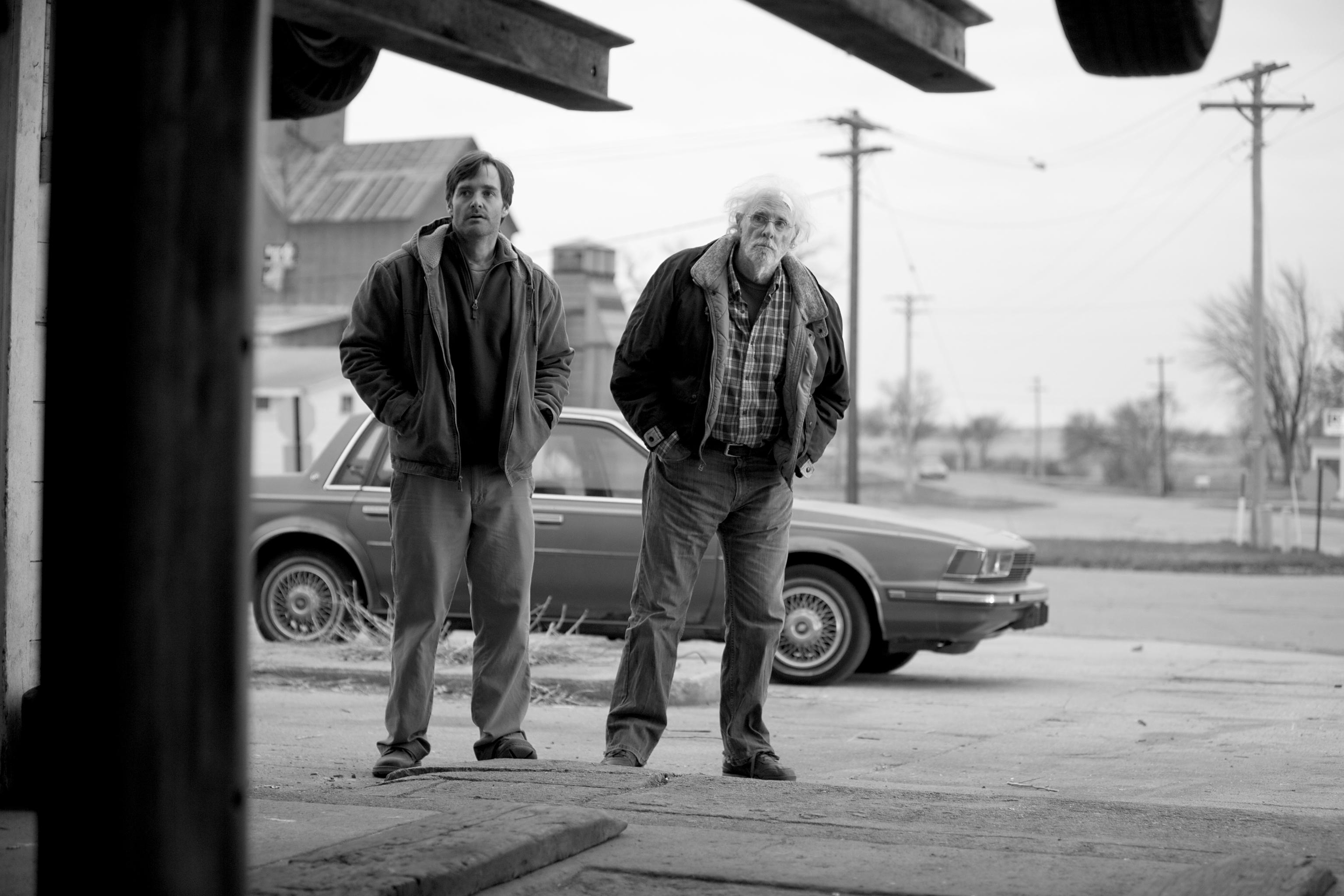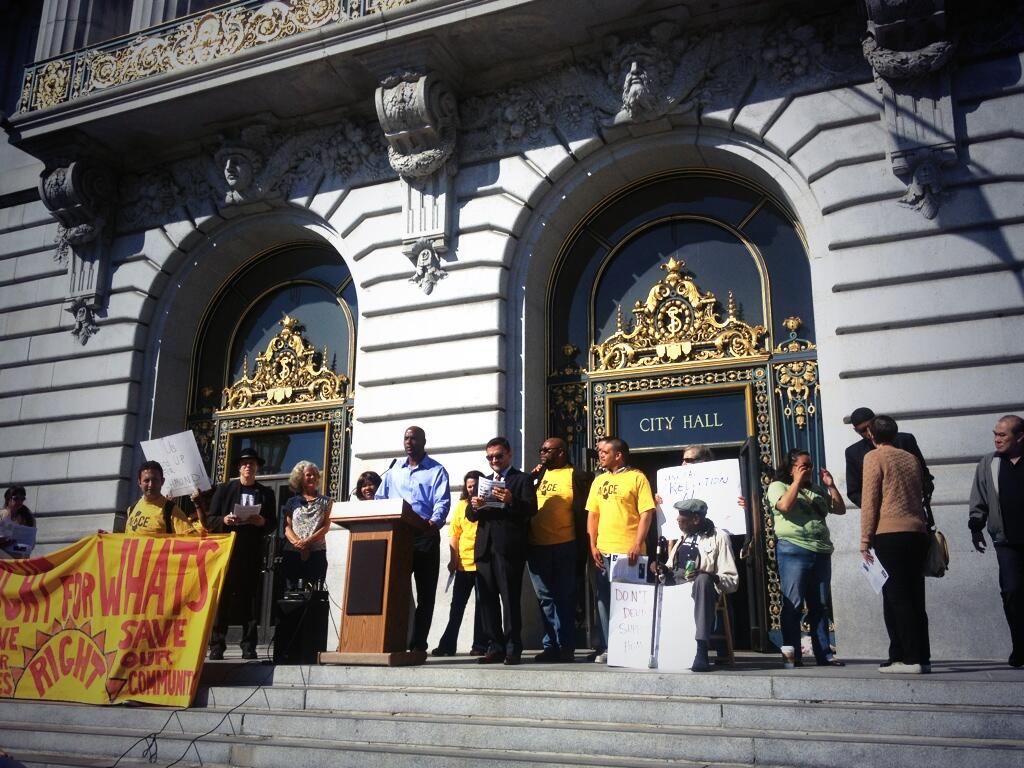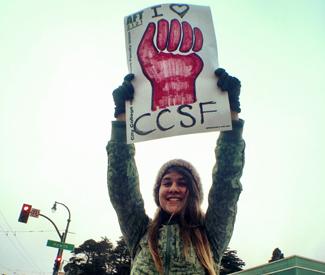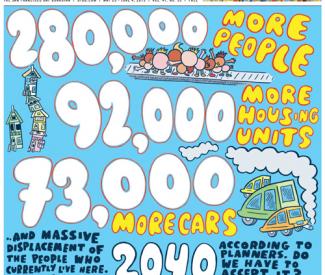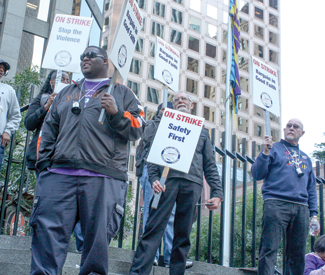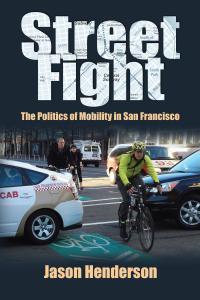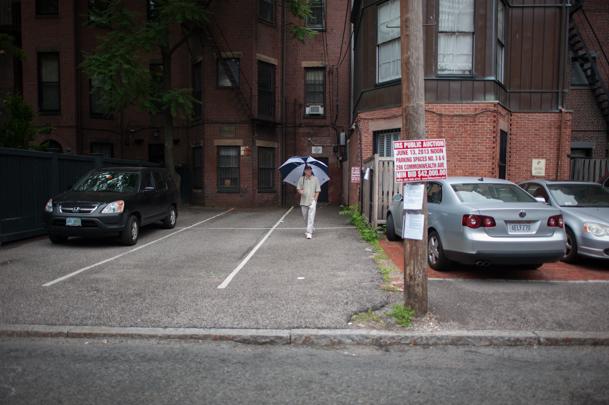Stage listings are compiled by Guardian staff. Performance times may change; call venues to confirm. Reviewers are Robert Avila, Rita Felciano, and Nicole Gluckstern. Submit items for the listings at listings@sfbg.com.
THEATER
OPENING
Amaluna Big Top at AT&T Park, Third Street at Terry A. Francois Blvd, SF; www.cirquedusoliel.com. $50-175. Opens Wed/13, 8pm. Check website for schedule, including special holiday showtimes. Through Jan 12. Cirque du Soliel returns with a show set on “a mysterious island governed by Goddesses and guided by the cycles of the moon.”
Arlington Magic Theatre, Fort Mason Center, 2 Marina, Bldg D, Third Flr, SF; www.magictheatre.org. $20-60. Previews Wed/13-Sat/16, 8pm; Sun/17, 2:30pm; Tue/19, 7pm. Opens Nov 20, 8pm. Runs Wed-Sat, 8pm (no show Nov 28; also Dec 4, 2:30pm); Sun and Tue, 7pm (also Sun, 2:30pm; no 7pm show Dec 8); Through Dec 8. Magic Theatre performs Victor Lodato and Polly Pen’s world-premiere musical.
Urge For Going Z Below, 470 Florida, SF; www.goldenthread.org. $10-45. Previews Thu/14-Fri/15, 8pm. Opens Sat/16, 8pm. Runs Thu-Sat, 8pm (no show Nov 28); Sun, 3pm. Through Dec 8. Golden Thread Productions presents Mona Mansour’s play about a Palestinian teen who hopes academics will be her ticket out of the Lebanese refugee camp she calls home.
BAY AREA
Harvey Barn Theatre, 30 Sir Francis Drake, Ross; www.rossvalleyplayers.com. $10-22. Previews Thu/14, 7:30pm. Opens Fri/15, 8pm. Runs Thu, 7:30pm; Fri-Sat, 8pm; Sun, 2pm (no show Sun/17). Through Dec 15. Ross Valley Players perform the Pulitzer-winning play by Mary Chase.
110 in the Shade Douglas Morrison Theatre, 22311 N. Third St, Hayward; www.dmtonline.org. $10-29. Previews Thu/14, 8pm. Runs Fri-Sat and Dec 5, 8pm (also Sat, 2pm); Sun, 2pm. Through Dec 8. Douglas Morrison Theatre performs N. Richard Nash’s romantic musical, adapted from his classic play The Rainmaker.
ONGOING
The Barbary Coast Revue Stud Bar, 399 Ninth St, SF; eventbrite.com/org/4730361353. $10-40. Wed, 9pm (no show Nov 27). Through Dec 18. Blake Wiers’ new “live history musical experience” features Mark Twain as a tour guide through San Francisco’s wild past.
Bengal Tiger at the Bagdad Zoo SF Playhouse, 450 Post, SF; www.sfplayhouse.org. $30-100. Wed/13-Thu/14, 7pm; Fri/15-Sat/16, 8pm (also Sat/16, 3pm). In Rajiv Joseph’s Pulitzer-nominated Bengal Tiger at the Bagdad Zoo, the dead quickly outnumber the living, and soon the stage is littered with monologist ghosts lost in transition. In Joseph’s world, at least, death is but another phase of consciousness, a plane of existence where a man-eating tiger might experience a crisis of conscience, and a brash young soldier with a learning disability might suddenly find himself contemplating algebraic equations and speaking Arabic — knowledge that had eluded his comprehension in life. Will Marchetti’s portrayal of the titular tiger is on the static side, though his wry intelligence and philosophical awakening comes as a welcome contrast to the willfully obtuse world view of the American soldiers (Gabriel Marin and Craig Marker) guarding him. But it’s Musa (Kuros Charney), a translator for the Americans and a former gardener and topiary “artist,” who eventually emerges as the play’s most fully realized character and also the most tragic, becoming that which he dreads the most, a beast in a lawless land, egged on by the ghost of his former employer, the notoriously sadistic Uday Hussein (Pomme Koch). At times, director Bill English’s staging feels too understated and contained for a play that’s so muscular and expansive (an understatement not carried over into Steven Klems’ appropriately jarring sound design) focused less on its metaphysical implications than on its mundane surface, but however imperfect the production and daunting the script, it remains a fascinating response to an unwinnable war — the war against our own animal natures. (Gluckstern)
BoomerAging: From LSD to OMG Marsh San Francisco, 1062 Valencia, SF; www.themarsh.org. $15-50. Tue, 8pm. Extended through Dec 17. Will Durst’s hit solo show looks at baby boomers grappling with life in the 21st century.
Driving Miss Daisy Buriel Clay Theater at the African American Art and Culture Complex, 762 Fulton, SF; www.african-americanshakes.org. $12.50-37.50. Fri/15-Sat/16, 8pm; Sun/17, 3pm. It’s 1948 in Atlanta, Ga., the same year that Martin Luther King Jr. joined the ministry at Ebenezer Baptist Church, and Daisy Werthan (Ann Kendrick) has just crashed her new Packard. Grudgingly forced into accepting a driver hired by her son Boolie (Timothy Beagley), she enters what will become a 25-year association with Hoke Coleburn (L. Peter Callender). Although she is a wealthy Jewish widow and he is a working-class African American man, they share a similar stubborn attitude, and although initially constrained by the manners of the time, the two gradually warm up to each other, their relationship evolving simultaneously with the mores of the South. In African-American Shakespeare Company’s production, Kendrick in the title role cuts a formidable figure yet ably reveals her character’s weaknesses and insecurities, while Callender as Hoke maintains an aura of quiet dignity and self-sufficiency; a hired man, but never a servant. Rounding out the excellent cast, Beagley as Boolie is the perfect foil for both his mother’s tendency towards imperiousness and her chauffeur’s sanguine sense of self. Charming, humorous, and subtly profound, Daisy ushers in the holiday season with a non-saccharine sweetness. (Gluckstern)
Emmett Till: A River NOH Space in Project Artaud, 2840 Mariposa, SF; www. theatreofyugen.org. $20-30. Thu/14-Sat/16, 8pm; Sun/17, 2pm. Taken from his bed in the dead of night and brutally killed for allegedly making a pass at a white woman, 14-year-old Emmett Till’s tragic demise helped to fuel the growing fires of the Civil Rights movement. But although his story has become deeply embedded within the fabric of American consciousness, it is usually recalled as a symbol for an oppressive system rather than representative of an actual human being. In an intriguing exploration of Till’s internal landscape, Kevin Simmonds and Judy Halebsky’s Emmett Till: A River at Theatre of Yugen takes Till’s story and fits it into a mugen (or phantasm) noh framework in which the restless spirit of Till encounters the woman in whose defense he was killed over 50 years earlier. As the performers remain seated, moving only to turn the pages of their score in unison, or to play their instruments, the experience is ritualistic in nature, a commingling of chant, poetry, and ghost story, expressed primarily via the sonorous vocals and heavy silences of Lluis Valls (as both Mamie and Emmett Till) and Sheila Berotti (as Carolyn Bryant). A gospel-style chorus of three African American voices (Derek Lassiter, Khalil Sullivan, and Dario Slavazza), the mournful flutes of Polly Moller, and the traditional percussion instruments and kakegoe vocals employed by David Crandall add tonal and atmospheric texture. (Gluckstern)
Foodies! The Musical Shelton Theater, 533 Sutter, SF; www.foodiesthemusical.com. $32-34. Fri-Sat, 8pm. Open-ended. AWAT Productions presents Morris Bobrow’s musical comedy revue all about food.
The Gershwins’ Porgy and Bess Golden Gate Theatre, One Taylor, SF; www.shnsf.com. $60-210. Tue-Sat, 8pm (no show Nov 28; check website for matinee schedule); Sun, 2pm. Through Dec 8. The Tony-winning Broadway revival launches its national tour in San Francisco.
Hedwig and the Angry Inch Boxcar Theatre, 505 Natoma, SF; www.boxcartheatre.org. $27-43. Thu-Sat, 8pm. Open-ended. John Cameron Mitchell’s cult musical comes to life with director Nick A. Olivero’s ever-rotating cast.
I Married an Angel Eureka Theatre, 215 Jackson, SF; www.42ndstmoon.org. $25-75. Wed/13-Thu/14, 7pm; Fri/15, 8pm; Sat/16, 6pm; Sun/17, 3pm. 42nd Street Moon performs the Rodgers and Hart classic.
The Jewelry Box: A Genuine Christmas Story The Marsh San Francisco, 1062 Valencia, SF; www.themarsh.org. $15-40. Fri, 8pm; Sat, 5pm. Through Dec 28. Brian Copeland performs the world premiere of his new, holiday-themed work, an Oakland-set autobiographical tale that’s a prequel to his popular Not a Genuine Black Man.
My Beautiful Launderette New Conservatory Theatre Center, 25 Van Ness, SF; www.nctcsf.org. $25-45. Wed-Sat, 8pm; Sun, 2pm. Through Dec 22. New Conservatory Theatre Center performs Andy Gram and Roger Parsley’s adaptation of Hanif Kureishi’s award-winning screenplay.
Peter and the Starcatcher Curran Theatre, 445 Geary, SF; www.shnsf.com. $40-160. Tue-Sat, 8pm (also Wed and Sat, 2pm; no show Nov 28); Sun, 2pm. Through Dec 1. Fanciful, Tony-winning prequel to Peter Pan.
The Rita Hayworth of This Generation Garage, 715 Bryant, SF; www.715bryant.org. $10-15. Wed-Thu, 8pm. Through Nov 21. Writer-performer Tina D’Elia’s 2010 solo comedy spins a queer and ethnically rich world that straddles the living and the dead in a Las Vegas that, let’s face it, lies somewhere between those two poles already. Drawing on her own professional obsession with Rita Hayworth (née Margarita Carmen Cansino), the ethnically neutered Hispanic star of 1940s Hollywood, D’Elia plays Carmelita, an ambitious Rita Hayworth impersonator who gets entangled with a Latino/a transgender blackjack champion with a drinking problem and too many deals with the devil — in the person of deceased Columbia Pictures mogul Harry Cohn’s daughter, a powerful Vegas TV host and Star-maker. Meanwhile, Carmelita’s smitten production manager Angel tries her best to look out for her, while would-be angel Rita Hayworth herself takes on the role of Carmelita’s consultant on all things Hayworth in a bid to earn her wings from a God moving in typically mysterious ways. While the piece requires patience with the usual formal pitfalls of the solo form (including some awkward back-and-forth between multiple characters) and the hefty plot could also use some editing, D’Elia (under director Mary Guzmán), in a production with few frills, proves a sharp and engaging performer, her characters tending to be both endearing and amusingly full-bodied. (Avila)
Scamoramaland Bindlestiff Studio, 185 Sixth St, SF; www.performersunderstress.com. $15-30. Thu/14-Sat/16, 8pm; Sun/17, 2pm. We’ve probably all received at least one “419” letter from a Nigerian prince-businessman-widow with a fortune abroad that must be reclaimed, for reasons not completely clear, by you and you alone. Eve Edelson’s play Scamoramaland (inspired loosely by her book of the same name) takes a closer look at these scams and attempts to flesh out what we never see online, namely, the faces behind the fraud. As such, however, it’s an incomplete look at best. We’re first introduced to Freddy (James Udom) a charming youth with a fast, flirty patter and a hunger for words, which has driven him to his strange profession, a writer of advance fee fraud scenarios for his boss or “oga” (Duane Lawrence), who holds his school fees hostage for more lucrative letters. As scam artists go, Udom’s Freddy is relatively likable, and it’s hard not to feel for him when a belligerent, wheelchair-bound “scambaiter” Tom (Scott Baker) begins to string him along. But as Freddy becomes more entangled in his unsavory trade, we never get a strong sense of what he is giving up by descending irrevocably deeper into the criminal underworld, his character remaining almost as two-dimensional as his loquacious online alter ego. As for the global socio-economic inequalities that drive such endeavors, they too are barely touched upon, and we’re left with a play that is more troubling than the comedy it’s billed as, but not unflinching enough to be truly transformative. (Gluckstern)
Shakespeare Night at the Blackfriars (London Idol 1610) Phoenix Arts Association Annex Theatre, 414 Mason, SF; www.subshakes.com. $20-25. Fri/15-Sat/16, 8pm; Sun/17, 7pm. Subterranean Shakespeare performs George Crowe’s comedy about a playwriting contest between Ben Jonson, Thomas Middleton, Francis Beaumont, and the ghost of Christopher Marlowe.
“Shocktoberfest 14: Jack the Ripper” Hypnodrome, 575 10th St, SF; www.thrillpeddlers.com. $25-35. Thu-Sat, 8pm. Through Nov 23. It’s lucky 14 for the Thrillpeddlers’ annual Halloween-tide Shocktoberfest, and while there are few surprises in this year’s lineup, there’s plenty of reliable material to chew on. Opening with A Visit to Mrs. Birch and the Young Ladies of the Academy, a ribald Victorian-era “spanking drama,” the fare soon turns towards darker appetites with a joint Andre De Lorde-Pierre Chaine work, Jack the Ripper. Works by De Lorde — sometimes referred to as the “Prince of Fear” — have graced the Hypnodrome stage over the years, and this tense Victorian drama, though penned in the 30s, is suitably atmospheric. Although it becomes pretty evident early on who dunnit, it’s the why that lies at the heart of this grim drama, and in the course of that discovery, the play’s beleaguered lawmen reveal themselves to be no less ruthless than the titular Ripper (John Flaw) in pursuit of their quarry. Norman Macleod as Inspector Smithson particularly embodies this unwholesome dichotomy, and Bruna Palmeiro excels as his spirited yet doomed bait. Inspired by Oscar Wilde’s Salome, the Thrillpeddlers’ piece by the same name is perhaps the weak link in the program, despite being penned by the ever-clever Scrumbly Koldewyn, and danced with wanton abandon by Noah Haydon. Longtime Thrillpeddlers’ collaborator Rob Keefe ties together the evening’s disparate threads under one sprawling big top media circus of murder, sex, ghosts, and sensationalism with his somewhat tongue-in-cheek, San Francisco-centric The Wrong Ripper. (Gluckstern)
Sidewinders Exit on Taylor, 277 Taylor, SF; www.cuttingball.com. $10-50. Thu/14, 7:30pm; Fri/15-Sat/16, 8pm (also Sat/16, 2pm); Sun/17, 5pm. Cutting Ball opens its 15th season with the world premiere of Basil Kreimendahl’s absurdist romp through gender queerness. In a cartoonish, desolate wasteland (designed by Michael Locher), Dakota (Sara Moore), a bleached-blonde gunslinger in buckskin fringes, and Bailey (DavEnd), a possibly AWOL soldier rocking high-heeled boots and a single drop earring, wrestle with the conundrum of what to call their respective genitals. And more to the point, what to do with them after they figure it out. Or as Bailey bluntly puts it, “Who am I supposed to fuck?” But there’s more to being stranded in the uncharted wilderness at stake than “organ confusion,” and soon they must channel their uncommon alliance into finding a way back out. What they find instead include a regal figure of indeterminate gender possessed of extra limbs (Donald Currie), a suicidal servant with surgical skills (Norman Muñoz), and a growing realization that wilderness, like identity, is relative. Moore and DavEnd make a good comedic team, their endless banter, circular logic and exaggerated facial gymnastics giving them the philosophical gravitas of a Looney Tunes episode, while Currie’s turn as mutated muse is unexpectedly moving. Recent winner of the prestigious Rella Lossy award, this intriguing world premiere marks playwright Basil Kreimendahl’s first professional production, though it seems safe to say that it won’t be the last. (Gluckstern)
Underneath the Lintel Geary Theater, 415 Geary, SF; www.act-sf.org. $20-150. Tue-Sat, 8pm (check website for matinees). Extended through Nov 23. A lone librarian (David Strathairn) takes the stage with a suitcase of “scraps” he will use to “prove one life and justify another.” To illustrate the first, he pulls a battered travel guide — 113 years overdue — from the case, and then, as the play continues, displays further “lovely evidence” to bolster his admittedly vague hypothesis. The life he is attempting to prove is that of the so-called “Wandering Jew,” but it’s the life he attempts to justify, namely his own, that becomes the more compelling, and his broadening horizons drive his narrative far more efficiently than his curious obsession with a man in a funny hat (who owes the library quite a fine for his century-delayed return of the guidebook). As a man who has rarely left the comfortable confines of his home town, Hoofddorp, traveling to London, China, New York City, and even Australia is nothing short of epic in the best sense of the word — a hero’s journey during which the benignly dotty librarian emerges transformed. Given the expanse of ACT’s Geary Theater mainstage, the production does suffer somewhat from a lack of intimacy, but moments of inventive staging take advantage of Nina Ball’s fantastically-cluttered set and the librarian’s innate sense of curiosity, as he unearths a wealth of evidence and fraught memories from the depths of the cavernous space. (Gluckstern)
BAY AREA
A Bright New Boise Aurora Theatre, 2081 Addison, Berk; www.auroratheatre.org. $32-50. Previews Wed/13, 8pm. Opens Thu/14, 8pm. Runs Tue, 7pm; Wed-Sat, 8pm; Sun, 2 and 7pm. Through Dec 8. Aurora Theatre presents Samuel D. Hunter’s tale of an ex-evangelical cult member attempting to bond with his estranged son before the end of the world.
Can You Dig It? Back Down East 14th — the 60s and Beyond Marsh Berkeley, 2120 Allston, Berk; www.themarsh.org. $15-50. Sat, 8:30pm; Sun, 7pm. Extended through Dec 15. Don Reed’s new show offers more stories from his colorful upbringing in East Oakland in the 1960s and ’70s. More hilarious and heartfelt depictions of his exceptional parents, independent siblings, and his mostly African American but ethnically mixed working-class community — punctuated with period pop, Motown, and funk classics, to which Reed shimmies and spins with effortless grace. And of course there’s more too of the expert physical comedy and charm that made long-running hits of Reed’s last two solo shows, East 14th and The Kipling Hotel (both launched, like this newest, at the Marsh). Can You Dig It? reaches, for the most part, into the “early” early years, Reed’s grammar-school days, before the events depicted in East 14th or Kipling Hotel came to pass. But in nearly two hours of material, not all of it of equal value or impact, there’s inevitably some overlap and indeed some recycling. Reed, who also directs the show, may start whittling it down as the run continues. But, as is, there are at least 20 unnecessary minutes diluting the overall impact of the piece, which is thin on plot already — much more a series of often very enjoyable vignettes and some painful but largely unexplored observations, wrapped up at the end in a sentimental moral that, while sincere, feels rushed and inadequate. (Avila)
Don’t Dress For Dinner Center REPertory Company, 1601 Civic, Walnut Creek; www.centerrep.org. $33-52. Wed, 7:30pm; Thu-Sat, 8pm (also Nov 23, 2:30pm); Sun, 2:30pm. Through Nov 23. Center REP performs Marc Camoletti’s sequel to his classic farce Boeing-Boeing.
A King’s Legacy Pear Avenue Theatre, 1220 Pear, Mtn View; www.thepear.org. $10-35. Thu-Sat, 8pm; Sun, 2pm. Through Nov 24. Pear Avenue Theatre performs Elyce Melmon’s world premiere, a drama about King James VI of Scotland.
A Little Princess Julia Morgan Theater, 2640 College, Berk; www.berkeleyplayhouse.org. $17-60. Thu-Fri, 7pm (Nov 28, shows at 1 and 6pm); Sat, 1 and 6pm; Sun, noon and 5pm (no 5pm show Dec 1). Through Dec 8. Berkeley Playhouse opens its sixth season with Brian Crawley and Andrew Lippa’s musical adaptation of the Frances Hodgson Burnett story.
Metamorphoses South Berkeley Community Church, 1802 Fairview, Berk; www.infernotheatre.org. $10-25. Thu and Sat-Sun, 8pm; Fri, 9pm. Through Nov 23. Inferno Theatre performs a multimedia, contemporary adaptation of Ovid’s classic.
The Pianist of Willesden Lane Berkeley Repertory Theatre, Thrust Theatre, 2015 Addison, Berk; www.berkeleyrep.org. $29-89. Tue and Thu-Sat, 8pm (also Dec 5 and Sat, 2pm; no show Nov 28); Wed and Sun, 7pm (also Sun, 2pm). Through Dec 8. Mona Golabek stars in this solo performance inspired by her mother, a Jewish pianist whose dreams and life were threatened by the Nazi regime.
Red Virgin, Louise Michel and the Paris Commune of 1871 Berkeley City Club, 2315 Durant, Berk; www.centralworks.org. $15-28. Thu-Sat, 8pm; Sun, 5pm. Through Nov 24. Central Works presents a new play (with live music) by Gary Graves about the Paris Commune uprising.
Social Security Muriel Watkin Gallery, 1050 Crespi Drive, Pacifica; (650) 359-8002. $10-25. Fri-Sat, 8pm; Sun, 2pm. Through Nov 24. Pacifica Spindrift Players performs Andrew Bergman’s classic comedy.
strangers, babies Ashby Stage, 1901 Ashby, Berk; www.shotgunplayers.org. $20-35. Wed/13-Thu/14, 7pm; Fri/15-Sat/16, 8pm; Sun/17, 5pm. Shotgun Players present Linda McLean’s drama about a woman confronting her past.
PERFORMANCE/DANCE
BATS Improv Bayfront Theater, B350 Fort Mason Center, SF; www.improv.org. $20. This week: “DuoProv Championship,” Fri, 8pm, through Nov 29; “Family Drama,” Sat, 8pm, through Nov 30.
“Be Bop Baby: A Musical Memoir: Z Space, 450 Florida, SF; www.zspace.org. Nov 19-21, 7pm; Nov 22-23, 8pm. $25-75. World premiere by Margo Hall and the Marcus Shelby Jazz Orchestra.
“Best of the 2013 San Francisco Fringe Festival” Exit Studio, 156 Eddy, SF; www.theexit.org. Fri/15-Sat/16, 8pm. $15-25. This week: Sarah Mackey’s Memphis On My Mind (“Best of” series continues through Nov. 23).
“Bitch and Tell: A Real Funny Variety Show” Garage, 715 Bryant, SF; www.ftloose.org. Fri/15-Sat/16, 8pm. $8-10. With Paco Romane, Rosemary Hannon, David Miller, Lindsay Wood, Bruce Yelaska, and others.
“Broadway Bingo” Feinstein’s at the Nikko, Hotel Nikko, 222 Mason, SF; www.feinsteinssf.com. Wed, 7-9pm. Ongoing. Free. Countess Katya Smirnoff-Skyy and Joe Wicht host this Broadway-flavored night of games and performance.
“The Buddy Club Children’s Shows” Randal Museum Theater, 199 Museum Wy, SF; www.thebuddyclub.com. Sun/17, 11am-noon. $8 (under 2, free). Dan Chan Magic Man performs dog tricks, illusions, and juggling.
“Con Nombre y Apellido” Fort Mason Center, Southside Theater, Marina at Laguna, SF; www.brownpapertickets.com. Thu/15-Sat/16, 8pm; Sun/17, 2pm. $35-40. Also Nov 23, 8pm, $45, Mtn View Center for the Performing Arts, 500 Castro, Mtn View. Theatre Flamenco of San Francisco presents renowned flamenco dancer Carola Zertuche.
CounterPULSE 1310 Mission, SF; www.counterpulse.org. This week: Year of the Snake with Jason Hoopes, Peiling Kao, and Karl Jensen, Fri/15-Sat/16, 8pm; Sun/17, 7pm, $10-15. “Beware the Band of Lions (They’re Dandy Lions),” with Bandelion, Sun/17, 3pm, free (reservations required as space is extremely limited; to request an invitation, email info@dandeliondancetheater.org).
“Fashioning Women” SOMArts Cultural Center, 934 Brannan, SF; www.brownpapertickets.com. Sat/16, 8pm. $25. Bay Area artist Kate Mitchell presents a dance/theater performance, book launch, and gallery show incorporating her faux costume designs.
Flyaway Productions Joe Goode Annex, 401 Alabama, SF; www.flyawayproductions.com. Wed/13-Sat/16, 7:30 and 9pm. $25. Director-choreographer Jo Kreiter and Flyaway Productions’ latest aerial composition banks off various aspects of female transcendence over the obstacles and confines of the modern world. That informs the deep structure of Give a Woman a Lift anyway — subtitled “a self-propelled, upward dash” — which is currently inhabiting the floor, walls, widows, and the very air within the high-ceilinged Joe Goode Annex. The piece has no narrative per se, but nevertheless evokes a sense of countless stories in both the sweeping grace and the spasmodic or reflexive contortions of its six performers (a lithe and forceful ensemble comprised of Christine Cali, Jennifer Chien, Becca Dean, Lisa Fagan, MaryStarr Hope, and Patricia Jiron). Further augmenting these proto-narrative tropes is an enveloping score by Jewlia Eisenberg and Laura Inserra, whose richly woven melodies are laced with images of women in flight and a repeated call to “rise up, fly girl.” Well-wrought and sympathetic as this fabric is, it can get in the way of some of the more immediately compelling parts of the dance, which makes fine use of the contact between the performers’ bodies and various (industrial) surfaces. These include discrete sections of rust-covered steel I-beams manipulated throughout as objects, supports, or as the central swinging platform suspended from the ceiling, which rises and falls throughout with dancers on and around it. There is something in that contact and negotiation which speaks to, but also reaches intriguingly beyond, the familiar tropes flagged by the “uplifting” aspects of the score and choreography. The latter is full of sweeping arcs and upended bodies, but also gestures that are unnecessarily histrionic. One ends up wondering what more silence and less affectation might have allowed to arise with this wonderfully kinetic and almost trans-human situation. (Avila)
“The Grawlix” Hemlock Tavern, 1131 Polk, SF; www.hemlocktavern.com. Fri/15, 9pm. $15. Club Chuckles hosts the Denver stand-up comedy troupe.
“Hysterical Historical San Francisco, Holiday Edition” Shelton Theater, 533 Sutter, SF; www.sheltontheater.org. Sun, 7pm. Through Dec 29. $30-40. Comic Kurt Weitzman performs.
“Mission Position Live” Cinecave, 1034 Valencia, SF; www.missionpositionlive.com. Thu, 8pm. Ongoing. $10. Stand-up comedy with rotating performers.
Megan Mullally and Stephanie Hunt Feinstein’s at the Nikko, Hotel Nikko, 222 Mason, SF; www.feinsteinssf.com. Thu/14-Fri/15, 8pm; Sat/16, 7pm. $45-65 ($20 food and beverage minimum). The performers present their band Nancy and Beth.
“Okeanos Intimate” Aquarium of the Bay, Pier 39, SF; www.capacitor.org. Sat, 4:30 and 7pm. $20-30 (free aquarium ticket with show ticket). Extended through Dec 28. Choreographer Jodi Lomask and her company, Capacitor, revive 2012’s Okeanos — a cirque-dance piece exploring the wonder and fragility of our innate connection to the world’s oceans — in a special “intimate” version designed for the mid-size theater at Pier 39’s Aquarium of the Bay. The show, developed in collaboration with scientists and engineers, comes preceded by a short talk by a guest expert — for a recent Saturday performance it was a down-to-earth and truly fascinating local ecological history lesson by the Bay Institute’s Marc Holmes. In addition to its Cirque du Soleil-like blend of quasi-representational modern dance and circus acrobatics — powered by a synth-heavy blend of atmospheric pop music — Okeanos makes use of some stunning underwater photography and an intermittent narrative that includes testimonials from the likes of marine biologist and filmmaker Dr. Tierney Thys. The performers, including contortionists, also interact with some original physical properties hanging from the flies — a swirling vortex and a spherical shell — as they wrap and warp their bodies in a kind of metamorphic homage to the capacity and resiliency of evolution, the varied ingenuity of all life forms. If the movement vocabulary can seem limited at times, and too derivative, the show also feels a little cramped on the Aquarium Theater stage, whose proscenium arrangement does the piece few favors aesthetically. Nevertheless, the family-oriented Okeanos Intimate spurs a conversation with the ocean that is nothing if not urgent. (Avila)
“Point Break Live!” DNA Lounge, 373 11th St, SF; www.dnalounge.com. Dec 6 and Jan 3, 7:30 and 11pm. $25-50. Interactive interpretation of Kathryn Bigelow’s 1991 classic. (Some tickets include meatball sandwiches!)
San Francisco International Hip Hop DanceFest Palace of Fine Arts Theatre, 3301 Lyon, SF; www.sfhiphopdancefest.com. Fri/15-Sat/16, 8pm; Sun/17, 2 and 7pm. $39.99-$75. The fest celebrates its 15th anniversary with performances by 13 hip-hop dance companies.
“San Francisco Magic Parlor” Chancellor Hotel Union Square, 433 Powell, SF; www.sfmagicparlor.com. Thu-Sat, 8pm. Ongoing. $40. Magic vignettes with conjurer and storyteller Walt Anthony.
“Seijin no Hi/Coming of Age” Japanese Cultural and Community Center of Northern California, 1840 Sutter, SF; www.brownpapertickets.com. Sun/17, 1pm. $17-25. Taiko drumming and dance company GenRyu Arts performs its 18th anniversary concert.
BAY AREA
Adventures of a Black Girl: Traveling While Black EastSide Cultural Center, 2277 International, Oakl; www.brownpapertickets.com. Fri-Sat, 8pm. Through Nov 23. $5-15. Edris Cooper-Anifowoshe performs her solo show.
Diablo Ballet Lesher Center for the Arts, 1601 Civic, Walnut Creek; www.lesherartscenter.org. Fri/15-Sat/16, 8pm (also Sat/16, 2pm). $20-52. The company’s 20th season kicks off with Our Waltzes Trilogy and A Swingin’ Holiday.
“The Intergalactic Nemesis: Book One: Target Earth” Zellerbach Hall, UC Berkeley, Bancroft at Dana, Berk; www.calperformances.org. Thu/14, 8pm. $18-42. A “live-action graphic novel” for ages seven and up.
“Rednecks, God, and Angelenos: The Worst of Randy Newman” Subterranean Art House, 2179 Bancroft, Berk; www.shotgunplayers.org. Sun/17, 8pm. $10-15. First Person Singular performs.
Savage Jazz Dance Company Laney College Theater, 900 Fallon, Oakl; www.savagejazz.org. Thu/14-Sat/16, 8pm. $10-20. The company performs its 2013 fall season, with repertory classics set to Wynton Marsalis and Philip Glass, plus a world premiere.
Unión Tanguera Zellerbach Hall, UC Berkeley, Bancroft at Dana, Berk; www.calperformances.org. Sun/17, 7pm. $18-48. The contemporary tango ensemble performs Nuit Blanche (2010). *


